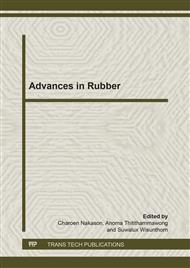[1]
F. Hennrich, C. Chan, V. Moore, M. Rolandi, M. O'Connell, Chapter one-The element carbon, Carbon Nanotubes: Properties and applications, CRC Press, Boca Raton (2006), pp.1-18.
DOI: 10.1201/9781420004212.ch1
Google Scholar
[2]
P.M. Ajayan, O.Z. Zhou M.S. Dresselhaus, Applications of carbon nanotubes, in: M.S. Dresselhaus, G. Dresselhaus, Ph. Avouris (Eds. ), Carbon Nanotubes, Topics Apply. Phys. 80, Springer-Verlag Berlin Heidelberg, 2001, pp.391-425.
DOI: 10.1007/3-540-39947-x
Google Scholar
[3]
I. Yakobson Boris, P. Avouris, Mechanical properties of carbon nanotubes, Carbon Nanotubes, Top. Appl. Phys. 80 (2001) 287-327.
DOI: 10.1007/3-540-39947-x_12
Google Scholar
[4]
S. Rodney Ruoff, C. Donald Lorents, Mechanical and thermal properties of carbon nanotubes, Carbon 33 (7) (1995) 925-930.
DOI: 10.1016/0008-6223(95)00021-5
Google Scholar
[5]
J. Justin Gooding, Nanostructuring electrodes with carbon nanotubes: A review on electrochemistry and applications for sensing, Electrochim. Acta 50 (15) (2005) 3049-3060.
DOI: 10.1016/j.electacta.2004.08.052
Google Scholar
[6]
J.N. Coleman, U. Khan, Y. K. Gun'ko, Mechanical reinforcement of polymers using carbon nanotubes, Adv. Mater. 18 (6) (2006) 689-706.
DOI: 10.1002/adma.200501851
Google Scholar
[7]
A. Mata, A. J. Fleischman, S. Roy, Characterization of Polydimethylsiloxane (PDMS) properties for biomedical micro/nanosystems, Biomed. Microdevices 7 (4) (2005) 281-293.
DOI: 10.1007/s10544-005-6070-2
Google Scholar
[8]
S.D. Burnside, E.P. Giannelis, Synthesis and properties of new poly (dimethylsiloxane) nanocomposites, Chem. Mater. 7 (9) (1995) 1597-1600.
DOI: 10.1021/cm00057a001
Google Scholar
[9]
Y.Y. Huang, S. V. Ahir, E.M. Terentjev, Dispersion rheology of carbon nanotubes in a polymer matrix, Phys. Rev. B 73 (12) (2006) 125422.
DOI: 10.1103/physrevb.73.125422
Google Scholar
[10]
M. Nour, K. Berean, M. J. Griffin, G. I. Matthews, M. Bhaskaran, S. Sriram, K. Kalantar-zadeh, Nanocomposite carbon-PDMS membranes for gas separation, Sens. Actuators, B: Chem. 161(1) (2012) 982-988.
DOI: 10.1016/j.snb.2011.11.079
Google Scholar
[11]
A. Khosla, B.L. Gray, Preparation, characterization and micromolding of multi-walled carbon nanotube polydimethylsilxane conducting nanocomposites polymer, Mater. Lett. 63 (13-14) (2009) 1203-1206.
DOI: 10.1016/j.matlet.2009.02.043
Google Scholar
[12]
C.G. Espinosa-González, F.J. Rodríguez-Macías, A.G. Cano-Márquez, J. Kaur, M.L. Shofner, Y.I. Vega-Cantú, Polystyrene composites with very high carbon nanotubes loadings by in situ grafting polymerization, J. Mater. Res. 28(8) (2013) 1087-1096.
DOI: 10.1557/jmr.2013.38
Google Scholar


